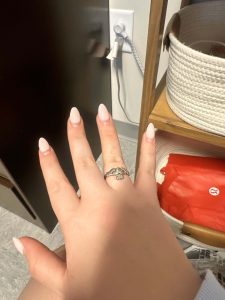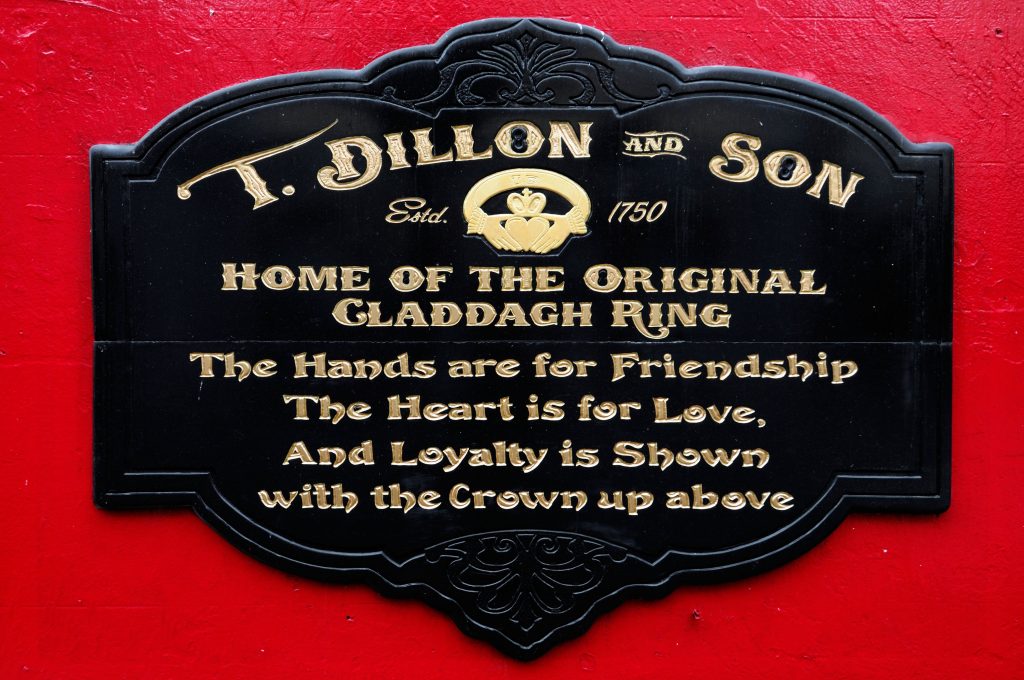1700 Claddagh Ring

Religion: Christianity
Time Period: 1700s
Type Of Garment: Ring
Tags: Catholicism, Everyday, Ireland, Richard Joyce, Thomas Dillon
The Object:

You may recognize this piece of jewelry as a popular family heirloom with roots in Irish culture. It is a simple band with three symbols that come together to create a cohesive design. The heart symbolizes love whether that be friends, family, or a romantic partner. The hands signify friendship and some may choose to emphasize this value. The crown represents loyalty to those who mean most to the individual wearing the ring. It is typically crafted in yellow gold, but can also be made in silver styles as well. The ring can also be customized and include a diamond or birth stone in place of the heart. Overall, it is very durable and able to withstand day to day wear and tear.
In addition to its craftsmanship and design, the ring carries symbolic power and rules govern the wearing of it. It conveys a message to the world depending on how it is presented (see Figure 1). When worn on the right hand, the heart pointed outward means that the wearer is single; facing inward represents a committed relationship. When worn on the left hand, the heart pointed out signals an engagement, and the heart facing inward means that the individual is married. Given these rules, Claddagh rings are often worn as substitutes for engagement or wedding rings. In fact, during some Irish ceremonies, it can be moved from the right hand to the left to celebrate the marriage and new union (Irish Family History Center).
The Creator:

History credits Richard Joyce with making the first Claddagh ring in 1700, and by around 1830 it was named for his home, the village of Claddagh, located in Galway, Ireland. Unconventional describes Joyce’s journey to a jewelry career, and although this account is not completely verified, history backs up many of the claims. According to the story, while on a voyage to the West Indies, Joyce was captured and sent to Algiers. Upon arrival, he was sold to a wealthy Turkish man who happened to be a goldsmith. He ended up teaching Joyce his trade (O’Neil 2020). Fourteen years later, at the request of King William III, all British subjects, including Joyce, were freed. When he finally returned to Galway, he settled into his career as a jeweler, married, and lived out the rest of his life there. The Claddagh ring’s design was said to come from heart and hand elements in other rings that were circulating at the time around the Mediterranean. Designs that Joyce would have seen while in Algiers. For example, Fede rings (see Figure 2), which refers to “Mani in Fede” or “hands clasped in faith,” date back to Roman times and feature a design with two hands clasped (McGrath 2023). Joyce’s twist on this motif became iconic and launched his successful career. (Irish Design 2017). Joyce’s original creation resembles the standard Claddagh ring design that we see today (see Figure 3).
Although Richard Joyce is long gone, his legacy lives on in the many ringmakers inspired by his work. Multiple versions of the Claddagh ring circulate online and at different jewelers. Among these is the Irish company, Thomas Dillon, who claims to be the “original manufacturers of the ring,” (Thomas Dillon’s 2024). (See Figures 3 and 4). They are located in Galway and established their shop in 1750, shortly after Joyce debuted his creation. Ever since, the company has dedicated itself to keeping the tradition alive and takes pride in the fact that they are only jewelers with a connection to Joyce and the stamp of originality. Thomas Dillon also has some of Richard Joyce’s earliest Claddagh rings on display, as well as other significant Irish artifacts. The jeweler encourages all to come visit “the smallest museum in Europe” and appreciate their history of Irish craftsmanship (Thomas Dillon’s 2024).
The Context:
When Richard Joyce first created the ring and returned to Galway, he gave it to his sweetheart who “wore it to symbolize their everlasting love,” (Irish History Centre). Given that Fede rings symbolized love and marriage, it makes sense that the Claddagh ring would build on this tradition. While little else is known about Joyce’s marriage, we do know that the ring gained popularity and was worn by many people throughout Galway. Traditionally, mothers pass it down to their daughters, but men can also wear one. Over time, the Thomas Dillon Company made rings for many increasingly noteworthy and popular clients including John F. Kennedy, Bing Crosby, Walt Disney, and Princess Grace Kelly (Thomas Dillon’s 2024). The ring has also been featured in popular media, including the Harry Potter films and Buffy the Vampire Slayer (McGrath 2023). Although the Claddagh ring started out as something worn by Irish people, it has transcended this niche market. Anyone who feels particularly drawn to it is invited to wear one, whether they are Irish or not.
Today the Claddagh symbol itself, apart from the ring, has become a prominent part of Irish culture. It symbolizes Ireland similar to other symbols, such as the shamrock and the harp. People and artisans incorporate the design into tattoos, record labels, art, and other pieces of jewelry (Ogham Art 2020). Further, in symbolizing Ireland and its heritage, the Claddagh ring also connotes the country’s longstanding and rich Catholic heritage. Many see the ring and its symbolism through the lens of Catholic Faith. For example, the Catholic Company states that the Claddagh ring “mirrors the virtues taught by the Church: love, loyalty, and faithfulness. The image of the heart under the crown reflects the love Christ has for us and our call to embody that love in our own lives. The hands holding the heart are reminiscent of the support and compassion that Christ offers humanity” (2024). This religious dimension, although not explicit or always considered, is intertwined with the symbolism and meaning of the ring.
The Wearers:

Mother McAuley Liberal Arts High School, an all-girl Catholic institution founded by Catherine McAuley, an Irish sister, is located in a heavily Irish Catholic part of the Southside of Chicago. At this school, which I attended, everyone I knew wore a Claddagh ring. It was so common that it was almost a part of our uniform. Close friends provided me with some insight into the cultural and religious significance of their rings. For instance, Noreen shared that it symbolizes her Irish roots. She added that although the ring does not directly invoke Catholicism, when she really thinks about it, it is a nice reminder of where she came from and what she believes in as a Catholic. She hopes to carry on this sentiment and pass it down to her future children (Personal Interview 2024). Similarly, my friend Cathy’s grandparents gave her a Claddagh ring and it symbolizes her Irish heritage (see Figure 5). She stated how, to her, it represents how important her heart is and how “she shouldn’t give it away to just anyone.” This coincides with the great significance of love and loyalty, not just to others, but to oneself. She would feel “devastated” if she lost it (Personal Interview). And my friend Ellie, in keeping with Irish tradition, was given her ring by her mother (see Figure 6). It is something that she cherishes deeply. For her, it represents “a transition into adulthood and womanhood” and she believes in its symbols of love, loyalty, and friendship (Personal Interview 2024).

While I am not Irish, my wearing a Claddagh ring reflects my faith, which has been deeply shaped by Irish Catholicism through my experience at Mother McAuley and relationships with my friends. It is something that is very important to my identity and will continue to be for the rest of my life. The values that the Claddagh ring stands for align with my personal beliefs. From these different reflections, we can see the entanglement of Irish history and Catholic virtues (loyalty, love, faithfulness) in this piece of jewelry. Although interpretations and reasons for wearing it can vary, there is one main thing that remains constant. The Claddagh ring represents an heirloom–a tradition–that keeps generations of people connected.
Marissa L. Mims, Psychology major with Religious Studies minor (WFU ‘27).
14 October 2024
Tags: Catholicism, Everyday, Ireland, Richard Joyce, Thomas Dillon
References:
Irish Family History Centre. n.d. “Everything You Need to Know About the Claddagh Ring.” Available at: https://www.irishfamilyhistorycentre.com/article/everything-about-claddagh-ring/.
The Catholic Company. n.d. “The Fascinating Legend of the Claddagh Ring – Get Fed.” Available at: https://www.catholiccompany.com/getfed/the-fascinating-legend-of-the-claddagh-ring/.
Ogham Art. 2020. “The Meaning of the Claddagh – OghamArt.” Available at: https://oghamart.com/blogs/news/the-meaning-of-the-claddagh.
Irish Design. 2017. “Richard Joyce; the Man behind the Claddagh Ring.” Available at: https://www.claddaghdesign.com/blogs/jewelry/richard-joyce-the-man-behind-the-claddagh-ring?srsltid=AfmBOoq8XslhCOpknnBbcEBfso4j_682Eo4qg-KcSRMLVtQ7IIigXmLO.
McGrath, Stuart. 2023. “The Claddagh Ring Meaning, Origin & Symbol.” Claddagh Rings. Available at: https://www.claddaghrings.com/the-meaning-and-origin-of-the-claddagh-ring/.

